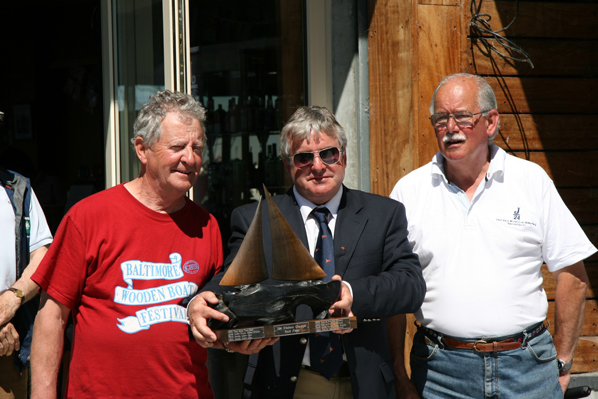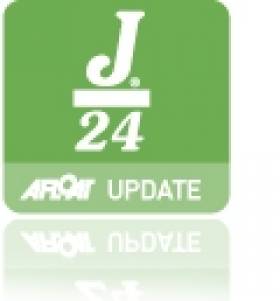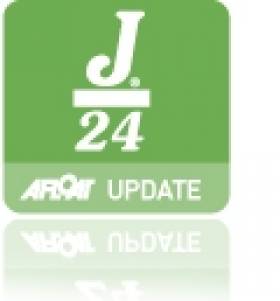Displaying items by tag: Lough Ree Yacht Club
Erne Yacht Wins Lough Battle for J24 Irish Title
#j24 – Lough Erne sailor JP McCaldin sailing Jamais Encore lifted the J24 title on Lough Ree last night by a three point margin. The Northern Ireland crew had a string of consistent results (full results downloadable below as jpeg file) with six results in the top three from eight races sailed in the 19 boat fleet.
Second overall on 27 points was a Royal Cork/Howth Yacht Club entry S/Touche (Darrer/Murphy) with another Howth Boat Crazy Horse skippered by Mossy Shanahan third on equal points.
Countback needed to decide J24 Western Championship
O'Driscoll, the Corkman who sails out of the Royal St.George but is racing in Howth this season in preparation for the forthcoming BMW European Championships there in September, got off to the perfect start by winning the first race but was black-flagged in the second, when victory went to local boat 'Jeb' (Andrew Mannion) ahead of 'Jibberish'.
Heavy squalls in race 3 mixed things up again with Stefan Hyde/Declan MacManus's 'Kilcullen' taking the gun from local man Stan Bradbury in 'Javelin'. The fourth race was sailed in Force 5+ winds and with most boats opting for jibs, it was 'Jeb' who took the honours and so lead overnight.
On the second day, Mickey McCaldin's 'Murder Picture' from Lough Erne won race 5 from 'Jibberish', a result that meant any of the top six could win the event going into the final race. O'Driscoll and crew held their nerve to beat O'Kelly et al to the line, leaving the two tied on points after the discard.
On countback, two race wins was enough to give the edge to 'Hard on Port' and 'Jeb' finishing third. Three points separated the top five points, illustrating the closeness of competition in this one-design keelboat class.
J24 Western Championships at Lough Ree YC - Results:
Hard on Port Flor O'Driscoll (RStGYC/HYC) 14ptsJibberish Fergus O'Kelly et al (HYC) 14 ptsJeb Andrew Mannion (LRYC) 16 ptsJavelin Stan Bradbury (LRYC) 16 ptsKilcullen Hyde/MacManus (RCYC/HYC) 17 pts
Lough Ree Yacht Club Annual Regatta Underway
Inland Waterways Vessels on Lough Ree at Athlone may meet large fleets of sailing craft at the southern end of Lough Ree approximately 3km north of Athlone due to Lough Ree Yacht Club Annual Regatta currently taking place.
Masters are requested to give racing fleets a wide berth where possible, however, if it is necessary to pass through a fleet to do so with due caution. The regatta will finish this Friday, 6th Aug 2010.
Marine VHF Channel 16 will be monitored by the principal race officer throughout the regatta.
Sun Shines on J24 Western Championships
"Lough Ree always had the water and the boats - They just needed the weather!" was the comment from Commodore of Lough Ree Yacht Club; Frank Murray.
Summer certainly obliged with blue skies, blazing sunshine, 24 degrees and moderate breeze on the Saturday 19th June and 27 degrees and light breeze on the Sunday 20th June for the J24 Western Championship 2010 held this year in Lough Ree Yacht Club.
Principal Race Officer for the Event; Derek Bothwell ran 6 windward/leeward races for the 16 boat fleet with notable visitors to Lough Ree of Stefan Hyde on "Nautigirl", Brian McDowell on "Scandal", Robin Eagleson in "Luder Too", Michael McCaldin, "Murder Picture", Flor O'Driscoll on "Hard on Port" and Emma McDonald who had never sailed a J24 prior to this event, borrowed local boat "Jaws".
Very close racing ensued with Flor ODriscoll taking the over all championship on 12 points, with local, Andrew Mannion in "Jeb Stuart" taking 2nd place on 16 points and first time J24 sailor Emma McDonald from Howth in 3rd place just one point behind.
A fantastic regatta that will be remembered for the hospitality of Lough Ree Yacht Club, the great racing and strangely for Ireland the fantastic summer weather.

Tight racing at the Leeward Mark - Lough Ree

L-R - Flor O'Driscoll, J24 Western Champion 2010, Frank Murray, Commodore LRYC, Robin Eagleson, President, IJCA-IRL
Photos courtesy of Alison Miles































































